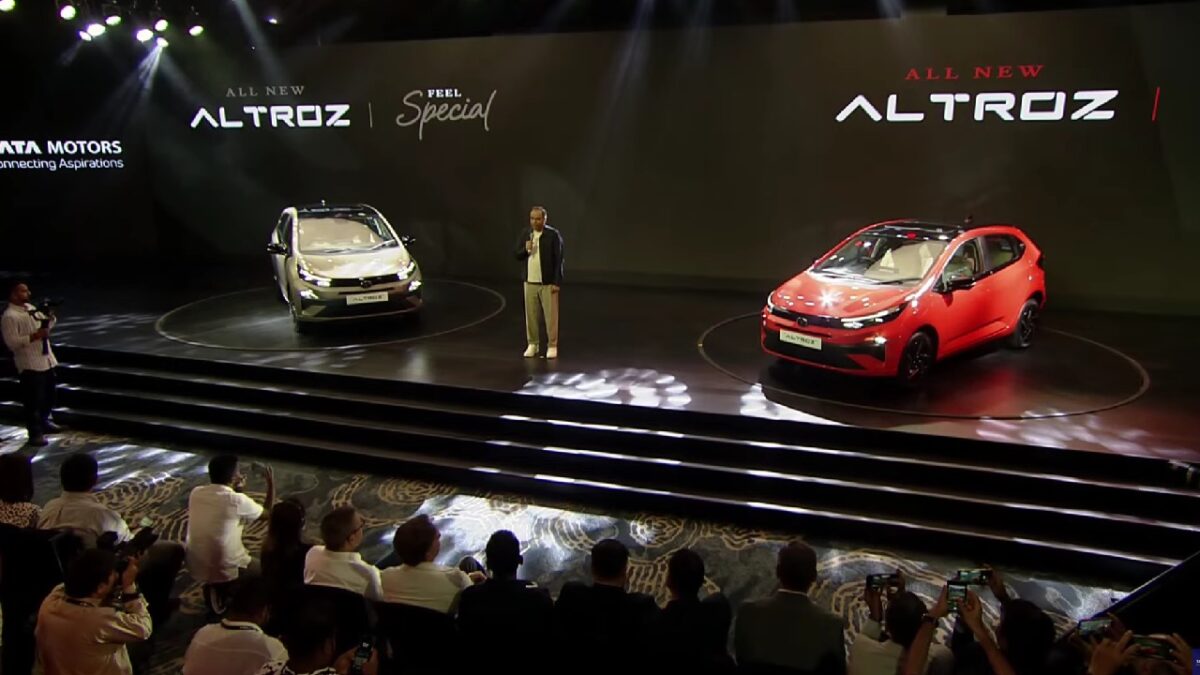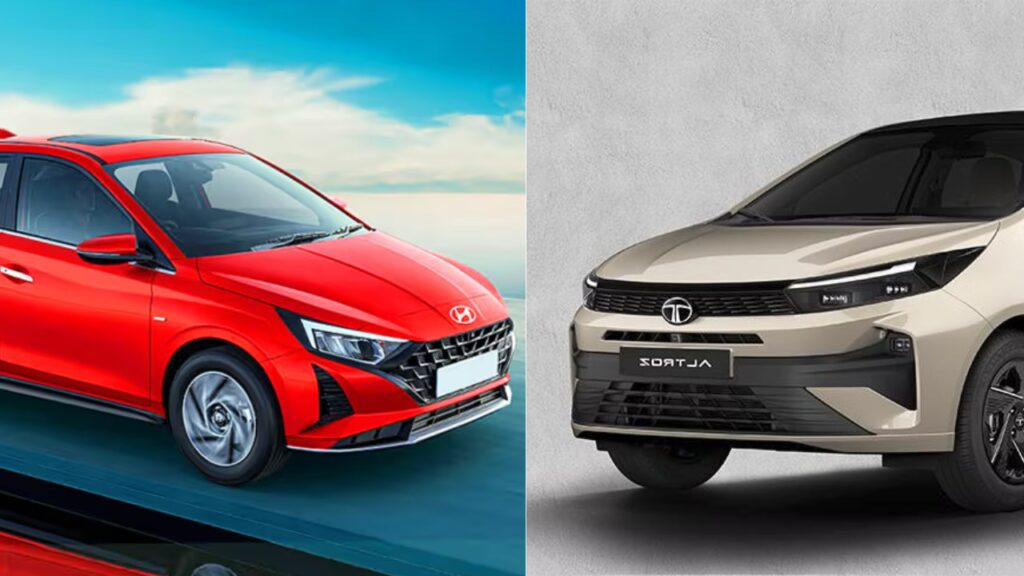The new Altroz has just been launched by Tata Motors and it comes with tons of new-age amenities, including design, features and a new transmission
In this post, we compare the new Tata Altroz facelift with the Hyundai i20 in terms of specs, features and price. Note that the premium hatchback segment is a unique space in our market. It positions itself perfectly between someone looking to buy an entry-level car or a mid-size SUV. In the last few years, the compact SUVs have taken a lot of market share away from cars like the Altroz, Baleno and i20. Still, these have been quite popular among the masses. Let us delve into the detailed comparison between the two.
Tata Altroz Facelift vs Hyundai i20 – Price
The new Tata Altroz facelift starts at Rs 6.89 lakh and goes up to Rs 11.49 lakh, ex-showroom. These are around the same prices as the pre-facelift model. On the other hand, the Hyundai i20 retails between Rs 7.04 lakh and Rs 11.25 lakh, ex-showroom. Hence, the Altroz has a slight edge when it comes to the entry-level version, while the i20 is more attractive at the top end.
| Price (ex-sh.) | Tata Altroz Facelift | Hyundai i20 |
| Base Model | Rs 6.89 lakh | Rs 7.04 lakh |
| Top Model | Rs 11.49 lakh | Rs 11.25 lakh |

Tata Altroz Facelift vs Hyundai i20 – Specs
Next up, let us compare the kind of specifications on offer on both these cars. The Tata Altroz facelift continues to draw power from a 1.2-litre 3-cylinder petrol engine, which makes 88 PS and 115 Nm (the same engine also offers a CNG avatar with 73 PS and 103 Nm), a 1.2-litre 3-cylinder turbo petrol (Altroz Racer) making 110 PS and 140 Nm and a 1.5-litre turbo diesel engine which generates a decent 90 PS and 200 Nm of peak power and torque, respectively. There are multiple transmission options to choose from, including a 5-speed manual, an all-new 5-speed AMT and a 6-speed DCA automatic. Hence, the needs of all sorts of buyers can be met with these engine-gearbox combinations.
On the other hand, even the Hyundai i20 is among a few cars which offer multiple powertrains in this space, including a 1.2-litre 4-cylinder naturally aspirated petrol and a 1.0-litre 3-cylinder turbo petrol in the N-Line guise. These generate 83 PS (88 PS with AT) / 114.7 Nm and 120 PS / 172 Nm of peak power and torque, respectively. Note that there is no diesel trim on offer. Performing transmission duties are a 5-speed manual, a CVT automatic, a 6-speed manual or a DCT gearbox. Again, all sorts of customers can choose what they want.
| Specs | Tata Altroz | Hyundai i20 |
| Engine | 1.2L Petrol / 1.2L Turbo Petrol / 1.2L CNG / 1.5L Diesel | 1.2L4-Cyl Petrol / 1.0L3-Cyl Petrol |
| Power | 88 PS / 110 PS / 73.5 PS / 90 PS | 83 PS (88 PS w/ AT) / 120 PS |
| Torque | 115 Nm / 140 Nm / 103 Nm / 200 Nm | 114 Nm / 172 Nm |
| Transmission | 5MT / 6 DCT / 5AMT | 5MT / 6MT / CVT / DCT |
| Boot Space | 345 L |
Tata Altroz Facelift vs Hyundai i20 – Features
This is a crucial aspect which a lot of people get drawn to while making a purchase decision. Modern cars come equipped with all sorts of the latest tech and convenience amenities to pamper the consumers. Hence, the amount of functionalities on offer on today’s vehicles is something that carmakers take seriously. Firstly, let us check out the kind of features the new Tata Altroz facelift comes with:
- UltraView 10.25-inch HD Infotainment by HARMAN
- UltraView 10.25-inch HD Digital Cluster (first-in-segment)
- 360 Degree HD Surround View System
- Smart Digital steering wheel
- Voice-Assisted Electric Sunroof
- Wireless Android Auto & Apple CarPlay
- Galaxy Ambient Lighting
- Rear AC Vents
- Express Cooling
- Height Adjustable Driver Seat
- Height Adjustable Seat Belt
- Cruise Control
- Clima Touch Automatic Temperature Control
- Wireless Smartphone Charger – Qi Support
- iRA Connected Vehicle Technology with 50+ Features
- In Built Map View in Cluster
- AudioWorX – Customizable Audio Modes
- Air Purifier
- SOS Calling Function
- 6 Airbags
- Electronic Stability Program
- ISOFIX Child Seat Mounts
- Hill Hold Assist
- Tyre Pressure Monitoring System
- SOS Calling Function (E-Call/B-Call)
On the other hand, the Hyundai i20 is among the most feature-laden products in its space. The top highlights include:
- Digital Instrument Cluster with TFT MID
- 10.25-inch HD Touchscreen Infotainment Display
- 7-Speaker Premium Bose Audio System
- Voice Recognition
- Hyundai Bluelink with OTA with Smartwatch Connectivity
- Home-to-Car (H2C) with Alexa Support
- Voice Enabled Electric Sunroof
- Auto AC with Digital Display
- Electrically Adjustable and Auto-Folding ORVMs
- USB-C Charger Socket
- Puddle Lamps
- Height adjustable seat belt – Driver & Passenger
- Bluelink Buttons (SOS, RSA & Bluelink) on IRVM
- Leather-Wrapped Steering Wheel and Gear Knob
- Soothing Blue Ambient Lighting
- Tilt & Telescopic Steering
- Rear Seat Adjustable Headrest
- 2-Tone Leather + Fabric Upholstery
- Drive Modes (Normal and Sports)
- Idle Stop & Go (ISG)
- Apple CarPlay and Android Auto
- Height Adjustable Driver’s Seat
- 6 Airbags
- Tyre Pressure Monitoring System
- ISOFIX Child Seat Mounts
My View
I must admit this has to be one of the closest comparisons you can come across. The prices are relatively similar and the features list is almost equally extensive on both cars. However, the main point of difference remains the availability of a diesel and CNG powertrain in the Altroz, which is missing in the i20. Still, I would encourage you to take a test drive of these two products and experience them in the flesh. You can’t go wrong with either of these compelling propositions.
Also Read: Hyundai i20 Magna Executive Variant Launched – Focus on Safety & Value


